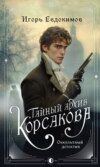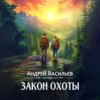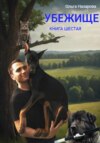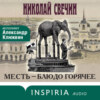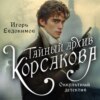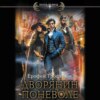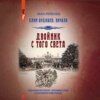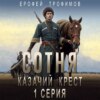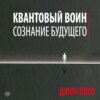Книгу нельзя скачать файлом, но можно читать в нашем приложении или онлайн на сайте.
Читать книгу: «Packing and Portaging», страница 6
CHAPTER XIV
WITH SNOWSHOES AND TOBOGGAN
IN the mode of travel here to be considered the voyageur, equipped with snowshoes, hauls his provisions and entire camping paraphernalia upon a toboggan or flat sled. The toboggan (Indian ta´-bas-kan´) had its origin in the prehistoric past among the Algonquin Indians of northeastern America. It was designed by them for the purpose of transporting goods over trackless, unbeaten snow wastes where sleds with runners could not be used, and for this purpose it is unequaled.
While for our purpose the conventionalized toboggan sold by outfitters and designed for hill sliding and general sport will answer very well, the wilderness model in use by Indians and trappers in our northern wilderness is a better designed and preferable type for the transportation of loads.
Various lengths of toboggans are in use, each intended for the particular purpose for which it was built. The longest Indian toboggan I ever saw was twelve feet in length, but from six to eight feet is the ordinary length, with a width of nine inches at the tip of the curved nose, gradually increasing to fourteen inches wide where the curve ends and the sliding surface or bottom begins, and tapering away to about six inches wide at the heel. The conventionalized type averages from four to six feet in length with a uniform width of about fifteen inches from curve to heel.
Some three or more crossbars, depending upon the length of the toboggan, are lashed at intervals across the top, the forward one at the beginning of the curve where the nose begins to turn upward, and on either side of the toboggan from front to rear side bar, and fastened to the side bars at their ends are side ropes.
Beaver-tail, bear's-paw, or swallow-tail snowshoes, of Indian make, are the shapes best adapted to the sort of travel we are considering. These models are all broad and comparatively short. The web should be of good caribou babiche, closely woven for use upon dry snow, and indeed for all-around conditions. While on wet, soggy snow a coarse web may in some respects be preferable it will not compare in efficiency with the close web on loose snow, or for all-around work under all sorts of conditions. Long, narrow snowshoes may be very good for racing where the country is smooth, but they are not suited to a rough, wooded or broken country or to hummocky snow.
The best and most practical, as well as the simplest sling or binding for the snowshoe is made as follows: Cut from an Indian tanned buckskin a thong about half an inch wide and thirty inches in length. Thread one end of this, from above down, through the web at one side of the toe hole, and from the bottom up at the opposite side. Pull it through until the two ends are even. Draw the thong up at the middle, where it crosses the toe hole, to make a loop large enough to admit the toe under it, but not large enough to permit the toe to slide forward against the forward cross-bar. Wrap the two ends of the thong around center of loop two or three times bringing them forward over the top and drawing them under and back through the loop. Slip your toes under the loop, bring the ends of the thong back, one on either side of the foot, and tie snugly in the hollow above your heel.
This sling will hold well, will not chafe the foot, and with it the snowshoe may be kicked free from the foot or adjusted to the foot in an instant.
Should the thongs stretch in moist weather, the sling may be tightened by simply taking an additional turn or two (without untying) around the toe loop.
I believe that lamp-wicking would answer as well as buckskin thongs, though I have never used it because I have always carried an ample supply of buckskin.
The best underclothing for the winter trail is good weight—though not the heaviest—woolen. Two suits should be carried besides the suit worn. Underclothing should not fit the body too snugly. It is better that it should be a size too large than an exact fit.
The outer shirt should be of flannel, and of good quality, though not too heavy.
Hudson's Bay Company trappers wear good-weight moleskin trousers, almost entirely to the exclusion of other fabrics, and I adopted them several years ago as superior to any other. They are wind-proof and warm and are particularly well adapted to the rough work of the trail.
The ordinary coat is not at all adapted to the northern wilderness in winter, for it will not protect against drifting snow and driving blizzard. In its stead the Eskimo adickey should be worn.
Any seamstress who can cut and make an ordinary work shirt can make an adickey if your outfitter cannot supply it. This garment is slipped on over the head like a shirt, and has a hood attached to draw over the cap as a neck and head protection. The neck opening is large enough to permit the head to pass through it without the necessity of a buttoned opening in front, for no matter how closely buttoned a garment may be drifting snow will find its way in. In length the adickey reaches half way between hip and knees and is made circular at the bottom. The hood should be of ample proportion to pull over the cap loosely, with a drawstring encircling the front by which it may be drawn snugly to the face. A fringe of muskrat or other fur around the face increases the comfort, the fur acting as a protection against drifting snow. While white Hudson's Bay Company kersey cloth is a favorite fabric for this garment, it may be made of any woolen blanket duffle or similar cloth.
Over the kersey adickey another adickey of some smooth-surfaced, strong material, preferably moleskin, should be worn. This outside adickey should of course be just enough larger than the kersey or blanket adickey to fit over it easily. The adickeys may be worn singly or together, according to the demands of the weather.
A Pontiac shirt, to be worn under the adickeys in extremely cold weather, should be included in the outfit. This will serve, too, in camp, when the adickeys are laid aside.
A round cap of fur or heavy cloth provided with flaps to turn down over the ears makes the best head protection. The hoods of the two adickeys, as before stated, should be large enough to draw over this.
Very important indeed is the question of foot dress. Not only must we aim to secure the greatest possible freedom and ease in walking, but the ever-present danger of frostbite must also be guarded against.
Socks should be of wool, of the home-knit variety, and besides the pair worn, three or four extra pairs should be carried in the kit.
Knit socks will not be sufficient protection, however, and where two or three pairs are worn they are certain to bunch or wrinkle, with chafed and sore feet as a result. All Hudson's Bay Company stores keep in stock a white fuzzy woolen duffle of blanket thickness. If you are making your start from a Post purchase some of this duffle and have one of the women at the Post make you a pair of knee-length stockings of the duffle to pull over your knit socks, and two pairs of slippers of the same material, one just large enough to fit over the foot of the long stockings, the other just a little larger to fit over all. These should be made of proper size, to obviate wrinkles. The larger outfitters carry in stock good wool duffle, and will make these to fit properly.
In crisp, cold weather, when the snow never softens or gets moist even under the midday sun, buckskin moccasins should be the outer footwear. Ordinary leather will freeze stiff, stop the proper circulation of blood, and certainly lead to frosted feet. The moccasins should be made with high tops, reaching above the ankles, with buckskin strings to wrap around and secure them. Moccasins are light to pack, and it is always well to carry a couple of extra pairs, to have on hand in case of emergency.
Leggings of moleskin (or some other strong, pliable cloth) large enough to push the foot through protect the legs. These should be knee high, with a drawstring to secure them just below the knee. Ordinary canvas leggings will not do. The leggings must be made in one piece, without side buttons or other fastenings, for otherwise snow will work through to the great discomfort of the wearer.
I have a pair of buckskin moccasins sewn to legs of harbor sealskin, the hair side of the sealskin out. This arrangement is preferable to separate leggings but sealskin legs are difficult to procure.
Ordinarily I have found one pair of knit socks, one pair of the long duffle stockings described above and one pair of the duffle slippers, worn inside the buckskin moccasins, quite sufficient.
The knit socks may be done away with entirely and also one pair of duffle slippers if rabbit-skin socks are to be had. These are worn with the hair next the foot, and are very warm and soft.
In weather when the snow softens and becomes wet at midday, buckskin moccasins will not do, for the least moisture penetrates buckskin. In such weather sealskin boots are the best foot protection. They are waterproof, pliable and light. Sealskin boots for this purpose have neither soles nor heels. They are simply sealskin moccasins with legs, secured with drawstrings below the knee. These are of Eskimo make, and not generally obtainable though they may be purchased in Newfoundland. Oil-tanned moccasins, or larrigans, are the next best moist-snow foot gear.
Buckskin mittens with one or two inner pairs of mittens of thick wool duffle, will protect the hands in the coldest weather. One pair should be a little smaller than the other, that it may fit snugly into the larger pair without wrinkles, and the larger pair of a size to fit in the same manner into the buckskin mittens. When the weather is too warm for both pairs, one pair may be removed. A fringe of muskrat or other fur around the wrists of the buckskin mittens protects the wrists from drifting snow.
A pad of rabbit-skin worn across the forehead will protect it from intense cold. Hunting hoods of knit camel's hair worsted are a pretty good head protection, particularly at night. They cover the whole head except the face, and may be drawn up over the chin. Mouth and nose must not be covered, or the breath will quickly form a mass of ice upon the face.
One caution, though it may seem a digression, may be made: If the nose or cheeks become frosted, as will certainly happen sooner or later to one traveling in a very low temperature, do not rub snow upon the frosted part. Snow rubbed on is pretty certain to fracture and remove sections of the skin. The Eskimo way is to hold or rub the frosted part with the bare hand until frost has been removed, and is far superior.
The clothing outfit above described will be found ample. Extra trousers or other extra outer garments are not needed. Let all hang loosely upon the body. Nothing should fit snugly.
A pair of smoked or amber goggles should always be included in the winter outfit. Amber is more effective than smoked glass, though ordinarily the latter will do. The goggles should be fastened with a string to slip over the back of the head. No metal should touch the flesh.
The best low temperature sleeping bag is one of caribou skin made with the hair inside. Under ordinary conditions, however, a waterproofed canvas bag lined with good woolen blankets will do as well, though such a bag with sufficient blanket lining to give it warmth equal to that of the caribou skin bag would be much heavier and more bulky than the latter. A bag lined with four thicknesses of llama wool duffle (that is, four thicknesses over and four beneath the sleeper), however, should not weigh more than ten pounds, and would correspond in warmth to one lined with blankets weighing twenty pounds.
An A or wedge tent will be found the best model for winter travel. A sheet-iron tent stove with bottom and telescoping pipe will make the tent warm and snug. The tent should be fitted with an asbestos ring at the stovepipe hole as a protection. A pack cloth or tarpaulin will serve as an adequate and comfortable tent floor.
It is never safe or advisable for one to travel in the wilderness alone, for a sprained ankle or broken leg in an isolated region would be more than likely to result in death.
In the Hudson Bay country two pounds of flour, one pound of fat pork, with baking powder, tea and sugar, form the daily ration for a man. It is well when possible to carry frozen fresh meat, free from bone, with a proportion of desiccated vegetables to vary the diet. Butter makes a tasty variety to the fat, for it will remain sweet at this season. Prunes and chocolate are both worth while.
Or if the journey is to be extended the menu may be simplified by the introduction of pemmican and the elimination of other articles. Pemmican is the best condensed food ever invented for cold weather work. One pound of pemmican and a quarter pound of pilot biscuit, as a daily ration, will sustain a man at hard work, though it will prove a monotonous diet. The above is merely suggested as a basis. It may be expanded or contracted as circumstances require without disturbing its mean value. Let it be remembered, however, that ordinary bread and other moist foodstuffs will freeze as hard as stone. Jerked venison and desiccated vegetables make tasty and sustaining additions to the ration, and will not freeze.
A man is supposed to be able to haul at good speed upon a toboggan a load equal to his own weight. Therefore two men, each weighing 150 pounds, should between them haul 300 pounds. Camp equipment, tent axes, guns, bedding, extra underclothing and all personal belongings of both, if proper care be exercised in selection, should weigh not to exceed 140 pounds. Add 80 pounds of food, and we have 220 pounds, or a maximum load of 110 pounds for each. The tent and general camp outfit is indeed sufficient for four men. It is presumed that the aluminum cooking outfit previously described will be chosen. Some eliminations, as, for example, that of the folding baker, might easily be made without serious loss of comfort.
To secure the load upon the toboggan, arrange the bags in which it is packed evenly, taking care that no part of the load extends beyond the sides of the toboggan. Adjust the tarpaulin or canvas ground cloth neatly over it. Secure one end of your lash rope to the side rope on one side at the rear. Bring the other end over and under the side rope opposite. Cross it back over the load and over and under side rope to front of next crossbar, and so on to front crossbar, taking slack as you proceed. From front to rear criss-cross rope in same manner over load and under side ropes, forming diamonds where the rope crosses itself on top of load. Bring the end of rope under side rope at rear, take in all slack and tie.
CHAPTER XV
WITH DOGS AND KOMATIK
IN considering equipment for dog and sledge traveling, we must constantly bear in mind the necessity of keeping down weight and bulk. Not long since, while visiting the establishment of a New York City outfitter, I saw an equipment which a sportsman ambitious for experience with dogs and komatik (sledge) had selected for a month's journey which he was about to undertake. Exclusive of provisions there was enough material to weight down four eight-dog teams. Among other things was a specially designed tent stove that would have tipped the scales at upwards of one hundred pounds.
The would-be traveler declared with pride that he "did not intend to have cold camps." It certainly gave me "cold feet" to contemplate his outfit. It was the most ridiculous and impracticable conglomerate aggregation of camping material that I have ever seen put together, and I doubt if the would-be traveler ever found a sufficient number of dogs at any one point to transport it.
While it is the aim of every experienced camper to obtain the greatest degree of comfort of which circumstances will admit, the voyager with dogs cannot hope to carry with him the luxuries of a metropolitan hotel, and one soon learns how little after all is really necessary to make one comfortable.
How much weight a team of eight good dogs can haul depends upon the character of the country and the condition of the snow or ice. Under very favorable conditions I have seen such a team make good progress with twelve hundred pounds. Ordinarily, however, eight hundred pounds is a full load, and if much rough ice, hilly country or soft snow is encountered six hundred pounds will be found all too heavy. I have heard of cases, when traveling was exceptionally good, of dogs covering upwards of one hundred miles a day. The biggest day's travel I ever made with dogs was sixty miles, but often I have toiled day after day, pulling and hauling with the animals at the traces, lifting the komatik over rough places, or packing a trail for the team with my snowshoes, to find myself rewarded with less than ten miles when camping time arrived.
In selecting outfit the region to be visited will be a factor to take into consideration. It would be quite impossible to discuss adequately in a single chapter all the phases of dog travel to be provided for. We shall therefore leave out of consideration polar outfitting, or outfitting for other unusual work, which the reader of this will scarcely be likely to undertake.
The clothing suggested in the chapter on snowshoe and toboggan travel is equally well suited to travel with dogs and komatik. Should the voyager's ambition, however, draw him within the sub-arctic regions or across the Arctic Circle some additional protection will be needed.
In the far Arctic the natives wear trousers of either polar bear skin or caribou skin, with an upper garment of caribou skin called, in Greenland, the "kulutar;" in Labrador, the "kulutuk." The only difference between the adickey and the kulutuk is that the one is made of cloth, the other of caribou skin. In Ungava I supplied myself with caribou skin trousers, which, as is the custom there, I drew on over my moleskin trousers in windy or intensely cold weather.
The kulutuk takes the place of the moleskin adickey. That is to say, the kersey adickey worn under the kulutuk will be found ample protection in any weather, and often the kulutuk of itself will be found sufficient.
Kulutuk and skin trousers are worn hair side out. Were they worn with the hairy side in, they would accumulate moisture exuded by the body, and the moisture would freeze, presently transforming the hair into a mass of ice. A friend of mine going to the Arctic for the first time as a member of one of Peary's early Greenland expeditions, turned his kulutuk inside out and donned it with the hairy side next the body. The Eskimos laughed, and resenting their levity he assured them it was much warmer worn in that manner than as they wore it. "No," said one of them, "if it were warmer worn that way the animals would wear their fur inside." My friend quickly learned by experience the logic of the Eskimo's argument.
Deerskin kulutuk and trousers are not easily purchased, though along any coast where seals are captured similar garments of sealskin may be procured, which, though not equal to deerskin garments, answer very well. The skin of the young harbor seal (the ranger seal) is best for the purpose, as skins of other species are too thick and heavy. When made of sealskin the upper garment is called a "netsek."
I discovered when traveling among them that some of the Moravian missionaries of the Labrador coast wore a buckskin suit under their ordinary trousers and outer shirt. Such a suit is much lighter than deerskin trousers and kulutuk, and serves nearly as well. It is not difficult to purchase buckskin from which one may have such a suit made. It is wind-proof and very light.
All skin garments, including moccasins, should be sewn with animal sinew. Ordinary thread will quickly break out and will not do. Thread-sewn moccasins are factory-made, and will give very little service.
The types of snowshoes suggested in the chapter on snowshoe and toboggan travel are the types also best suited to dog and komatik work. Long snowshoes would be very much in the way when one has to go to the traces and haul with the dogs or lift and assist the komatik over rough places; and this becomes the rule rather than the exception as one goes North.
Let me insist that the web should be of good caribou babiche, and not the ordinary rawhide used in many of the snowshoes offered for sale. The former will not stretch when wet, while the latter will stretch and bag so badly as to render the snowshoe practically useless.
It is well to wrap the frame on either side where the babiche is drawn around it, with buckskin or sealskin. Otherwise even a slight crust upon the snow will in time cut the babiche strands. Wrapping the snowshoe in this manner will at least double its life.
What was said in reference to tent, small sheet-iron stove and general camp and cooking outfit in the previous chapter will apply here, as well as directions heretofore given for packing in waterproof bags. In selecting the sleeping bag, give first preference to one of deerskin.
In a barren region where firewood is not to be had, it will be necessary to carry an alcohol or kerosene burner and stock of fuel. The former is preferable on account of the low freezing point of alcohol. Alcohol or oil should be secured in tin cases. It is regularly put up in this way by dealers.
In such a region, too, it may be necessary to carry snow knives with which to cut blocks of snow for the erection of snow igloos as shelter. These knives resemble somewhat the machete. One cannot, however, learn to build a snow igloo properly without long practice. This phase of the work is merely referred to as interesting; for anyone traveling in a country where snow house shelter is necessary will secure the assistance of a native, who will attend to proper sledge outfitting at the point of departure.
On regular lines of dog travel opportunities to renew the provision supply will frequently occur, and cabins for night shelter will be found. Therefore the food outfit will depend upon the country to be traversed. Where long stretches occur between supply points, however, fat pork, pilot bread, tea and sugar should form the basis. The very best possible food, however, for this work is pemmican, pilot bread, tea and sugar. Of course a little coffee may be carried, but it is bulky.
The traveler will make his selection carefully, building around pork, pilot bread and pemmican with other articles of food like desiccated vegetables from which water has been eliminated. Too much salt meat opens the door to scurvy, unless sufficient variation in the way of vegetables, fish, or fresh meat is introduced. Dessicated cranberries are an excellent preventive. A man can do good hard work day in and day out, as already stated, upon one pound of pemmican and a quarter pound of pilot bread as a daily ration, and such a ration offers no danger of scurvy.
Dog pemmican is the best dog food, and the lightest, for dogs will do pretty well upon one pound of pemmican each a day. To do well the animals should be given plenty of fat, when pemmican is not available, though not a clear fat diet, for that will make them sick. Three-quarters of a pound of fat and three-quarters of a pound of meat or fish is an ordinary ration. Dogs are fed but once a day—at night.
The number of dogs in a team varies, but the average team is composed of seven or eight. Eight or nine is the most economical number so far as results are concerned.
In the Northwest dogs are harnessed tandem. This is the white man's method. In the Northeast they are harnessed fan fashion—the Eskimo method. That is to say, each dog has an individual trace secured to the end of a single thong, leading out from the bow of the komatik and called the bridle. The individual traces are of various lengths. The dog with the longest trace is the leader of the pack, and particularly trained to respond to the driver's directions. The other dogs will follow his lead.
For open country and sea ice travel the Eskimo method is probably best, as the work is more evenly distributed and the driver can always tell whether each dog is doing his share of the work, but for narrow trails and woods travel the tandem method is more practicable.




